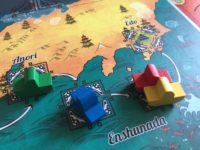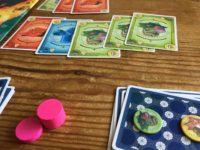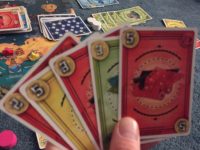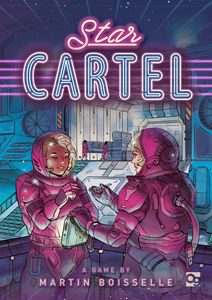- Learning time
- 20 minutes
- First play time
- 60 minutes
Traders of Osaka
Designed by: Susumu Kawasaki
In Traders of Osaka you are the traders in question, attempting to out-commerce the other traders in a battle of wits, wheeler-dealing and high-speed nautical winds. It was previously published as Traders of Carthage.
The game comes with a small board showing part of Japan, complete with the route four ships will sail – from Osaka, where you buy your goods, to Edo where you sell them. The meat of the game is in the cards, which represent the goods in question and have a number value of 2, 3 or 5. For simplicity’s sake we’ll refer to them by colour: red, blue, yellow and green. Players are dealt a hand of five of these cards, five more go face-up in a common Market area, and three more at the Farm.
On your turn you have three possible actions: take a card from the market, reserve a card at the market or the farm, or buy all the market cards, at which point cards at the Farm (plus two more from the deck) become the new Market, and three new cards are dealt to the Farm.
Taking a card is simple – add it to your hand. Cards in your hand represent money, and the colour is irrelevant. Reserving is simply placing a marker on a card to prevent anyone else taking it – you can either pick it up or buy it on a future turn.
Buying market cards is spending the cash in your hand to purchase everything at the market. You must buy everything (excepting cards reserved by other players) and these market cards don’t go into your hand but instead form face-up sets in front of you; goods you hope to sell. When cards are bought from the market, the matching-coloured ships move along the sea route towards Edo: one space for a single card, or two spaces for two or more cards. If one or more ships reach Edo then the cargo they carry can be sold for points, following a simple calculation: the highest-numbered card in the set multiplied by the amount of cards in the set; then the result rounded up to the nearest multiple of five, and every ‘5’ in this calculation equalling a point. For instance, you have a set of three yellow cards and the highest number in the set is 3. 3×3= 9, rounded up to 10: that’s two points. Points are tracked by turning delivered cards face-down into a points pile.
Every time you sell goods at Edo you take a matching-coloured Achievement token, which counts as an extra multiplier next time you deliver goods of this type… so taking our above example of the yellow cards, let’s imagine the yellow boat reaches Edo again and you now have four yellow cards with the highest number 5. Your achievement token is basically an extra ‘card’, so your initial calculation is 5×5 instead of 4×5.
After ships deliver to Edo, they are returned to Osaka again to begin the journey once more.
The catch – and the reason why Traders of Osaka is not as simple, – calculus aside – as it might initially sound, is that whenever a ship reaches Edo any ships still out in the depths of the sea (the two Enshunada spaces just before reaching Edo) are lost: these ship pieces move back to Anori and any sets you might have in their colour get dumped into the discard pile – although there is a way to minimise the damage by spending cards to insure this cargo. Once insured, it can never be ‘lost’ again.
As soon as any player reaches 8 achievement tokens, the game ends: most points wins.
Joe says
I played the original of this, Traders of Carthage, and found it a really enjoyble card game for two, with the extra dimension of the little board adding hugely to the appeal. A bit of a classic.
The guru's verdict
-
Take That!
Take That!
Whilst not an overt aspect of buying and selling, there are certainly interactive elements of the game that might not be clear from the rules briefing above. You can take cards from the market to not only stop an opponent getting them, but prevent a ship from moving - and deliberately 'sink' ships players have invested in by making sure another ship makes it to Edo whilst they are languishing at sea - tantamount to sabotage really, but that's the game...
-
Fidget Factor!
Fidget Factor!
Just like a ship waiting for wind, there are possible lulls.
-
Brain Burn!
Brain Burn!
Although the scoring system is not the most intuitive, it's pretty simple. The brain burning here is all to do with timing: what to take when, predicting what the other players might do, and trying to avoid your precious cargo going down with the ship.
-
Again Again!
Again Again!
It's light enough to play in half an hour, but far from predictable.














Sam says
What initially appeared a gentle game of set-collection and delivery revealed itself to be a shrewd, devious, scheming and potentially nasty battle of wits, where you might even sink a ship you've invested in if it prevents another Trader cashing in a big haul. The ships-at-sea sinking just because another ship reached Edo might make no sense at all in terms of theme/realism, but it certainly gives the game a tension that some will relish - not for the faint-hearted, this one! Probably best with 2 - the more players there are, the less control you really have - but still fun with 3.